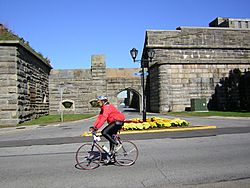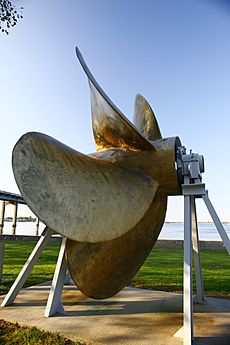Fort Schuyler facts for kids
Quick facts for kids Fort Schuyler |
|
|---|---|
| Part of Harbor Defenses of Eastern New York 1898–1934 | |
| Throgs Neck at East River and Long Island Sound, New York, New York | |

Southern main gate
|
|
| Coordinates | 40°48′20″N 73°47′31″W / 40.80556°N 73.79194°W |
| Type | Garrison fort, training camp |
| Site information | |
| Owner |
|
| Controlled by |
|
| Open to the public |
Yes |
|
Fort Schuyler
|
|
| Area | 17 acres (6.9 ha) |
| Built | 1833–1856 |
| Architect | Capt. I.L. Smith (probably John Lind Smith (died 1858) of the US Army Corps of Engineers) |
| Architectural style | Third system of US fortifications |
| NRHP reference No. | 76001206 |
| Significant dates | |
| Added to NRHP | June 29, 1976 |
| Condition | Intact, occupied |
| Site history | |
| Built by | United States Army Corps of Engineers |
| In use | 1861–present |
| Battles/wars | American Civil War World War I |

Fort Schuyler is a historic fort located in the Bronx, a part of New York City. It was built a long time ago, in the 1800s, to protect the city. Today, this amazing old fort is home to a museum, a library, and offices for the State University of New York Maritime College. Many people think it's one of the best examples of old forts from the early 19th century. The fort was named after Major General Philip Schuyler, a hero from the Continental Army.
Contents
Discovering Fort Schuyler's Past
Fort Schuyler was one of many forts built along the East Coast of the United States after the War of 1812. This war showed that the U.S. coast needed better protection from attacks by other countries. Construction on Fort Schuyler began in 1833 and it was mostly finished by 1856. Soldiers didn't move in until 1861.
The fort was placed in a very important spot. It guarded the eastern entrance to New York Harbor, protecting New York City from ships coming through Long Island Sound. It sits on Throggs Neck, which is the southeastern tip of the Bronx. Another fort, Fort Totten, was built across the river. Together, these two forts could create a strong defense, making it very hard for enemy ships to reach New York City.
How Fort Schuyler Was Built
At its busiest, Fort Schuyler had 312 guns and could hold 1,250 soldiers. The United States Army Corps of Engineers designed and built it. Its location on Throggs Neck meant that four of its five sides faced the water, ready to defend.
The fort had three levels of cannons on its water-facing sides. The bottom two levels were inside strong, arched rooms called casemates. The top level had cannons mounted on the roof, called barbette mounts. Special "tower bastions" were at the corners where the water-facing sides met. These had smaller guns called howitzers to protect the fort's walls from attackers.
Behind the main fort, there was a large outer defense area called a hornwork. This was unique for forts of its kind. It had walls and points designed to break up any land attack.
Fort Schuyler During the Civil War
During the American Civil War, Fort Schuyler played several important roles. It held up to 500 prisoners of war from the Confederate States Army. It also housed soldiers from the Union Army who had committed military offenses.
The fort also had a large hospital called McDougall Hospital, which could care for 2,000 patients. People said the fort had a very good system for removing waste, which was advanced for its time.
Fort Schuyler was also a place where soldiers trained before going to war. Famous units like "Duryee's Zouaves" and parts of the "Irish Brigade" trained here. Life at the fort was often quiet for the soldiers, as they mostly served as guards and hospital workers, not as artillery gunners.
Modernizing the Fort
Later, around the late 1800s, Fort Schuyler was updated with newer, more powerful coastal artillery guns. This was part of a big plan to improve defenses along the coast. New batteries were added with large 12-inch and 10-inch guns that could hide when not firing. Smaller 5-inch and 3-inch guns were also installed.
However, after World War I began in 1917, some of these guns were removed. They were sent to France to be used as field guns, but the war ended before they saw action. Over time, many of the older guns were removed or scrapped. By 1934, the fort was no longer used for defense and was given to the state of New York.
A College Home
In the late 1920s, the U.S. Army decided they no longer needed Fort Schuyler. A famous city planner, Robert Moses, wanted to turn it into a state park. However, another plan won out: it became the permanent home for the New York State Merchant Marine Academy.
The fort was fixed up by the Works Progress Administration, a government program during the Great Depression. In 1938, it officially became home to the academy. This school, now called the State University of New York Maritime College, still uses the fort today. In 1948, it became one of the first schools to join the State University of New York. Fort Schuyler has been recognized as a historic place since 1976.
Maritime Industry Museum
Since 1986, a part of Fort Schuyler has been home to the Maritime Industry Museum. This museum teaches visitors about the history of shipping in the United States. You can learn about commercial ships, the merchant marine, and the important port of New York. The museum also has exhibits about the history of Fort Schuyler itself. It's open to the public on weekdays for guided tours and on weekends for self-guided visits.
See also





